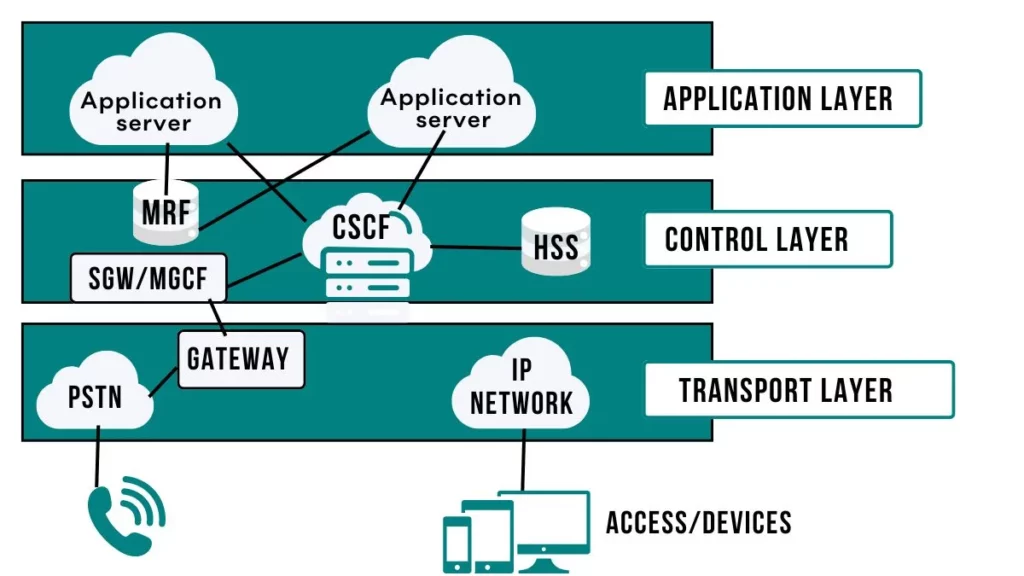The IP Multimedia Subsystem (IMS) is a technology in modern telecommunications. It allows different media types, like voice, video, and messaging to work together over various networks. IMS is essential for providing advanced communication services that are flexible and efficient.
IP Multimedia Subsystem
IMS stands for IP Multimedia Subsystem. It is a system that allows multimedia services to run over IP networks. The idea was developed by a group called the 3rd Generation Partnership Project (3GPP). They created IMS to support new communication services and integrate them into a single framework.
Architecture of IMS
IMS has a layered architecture. Each layer has a specific role in managing and delivering services. This structure helps in organizing and controlling different tasks within the system.

- Control Layer:
The control layer is responsible for managing communication sessions. It handles tasks like setting up calls, changing them, and ending them. - Application Layer:
This layer provides the actual services, such as voice calls, video conferencing, and messaging. It allows users to access these services seamlessly. - Transport Layer:
The transport layer is in charge of transmitting data. It ensures that information flows smoothly over different networks.
Components of IMS
The following are the IP Multimedia Subsystem components:
- Home Subscriber Server (HSS):
The HSS manages user information, such as authentication and profiles. It ensures that users can access the services they need. - Call Session Control Function (CSCF):
There are three types of CSCF: Proxy (P-CSCF), Interrogating (I-CSCF), and Serving (S-CSCF). These functions manage session control, routing, and service handling. - Media Gateway Control Function (MGCF):
MGCF interfaces with older networks. It allows IMS to work with legacy systems. - Application Servers (AS):
Application servers host the multimedia services. They provide functionalities like messaging, video calls, and other applications. - Media Resource Functions (MRF):
MRF handles media processing tasks, such as mixing audio or video streams during a conference call.
How IMS Works
- Session Initiation Protocol (SIP):
SIP is a protocol used in IMS. It helps establish, manage, and terminate communication sessions. SIP ensures that all parties in a session are connected and communicating properly. - Process Flow:
When a multimedia session starts, the system receives a request. The system then sets up the session, manages it, and finally terminates it when the communication ends.
Applications of IMS
Multimedia Services:
IMS enables a wide range of multimedia services, including:
- Voice over IP (VoIP):
VoIP allows voice communication over the internet. - Video Conferencing:
This service enables video calls between users. - Instant Messaging:
Users can send text messages instantly to one another. - Multimedia Streaming:
Streaming allows users to watch or listen to content in real time.
Use Cases of IMS
IMS is used in various real-world scenarios. For example:
1. Emergency Services
IMS helps improve emergency response through enhanced 911 (E911) services. When someone makes an emergency call, IMS provides better location and communication details. This helps emergency responders get to the right place faster.
2. Telecom Providers
Telecom companies use IMS to offer a range of services to their customers. They provide integrated voice calls, video calls, and messaging. IMS makes it easy for these companies to manage and deliver these services smoothly.
3. Corporate Communication
Businesses use IMS for their communication needs. It helps with unified communications, which means combining various communication tools into one system. This includes Voice over IP (VoIP) for phone calls and video conferencing for meetings.
Benefits of Using IMS
- Enhanced Service Delivery:
IMS makes it easier to deliver advanced services. Users can enjoy high-quality communication without interruptions. - Cost Efficiency for Service Providers:
IMS reduces costs by using a single platform for multiple services. This saves money for telecom companies. - Improved User Experience:
IMS provides seamless connectivity. Users can switch between different services without losing quality. - Interoperability:
IMS works across different network types, such as mobile, fixed, and satellite networks. This makes it a versatile solution for telecom providers.
Challenges and Limitations
- Technical Complexity:
Implementing IMS can be challenging. The technology is complex and requires careful planning and execution. - Market Adoption:
Although IMS offers many benefits, its adoption has been slow. Factors like cost and complexity have affected its widespread use.
Also Read:
